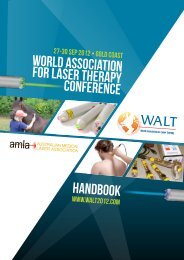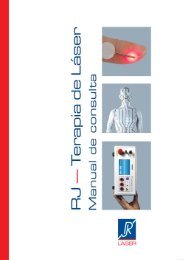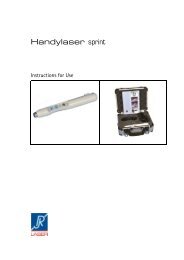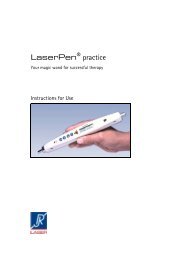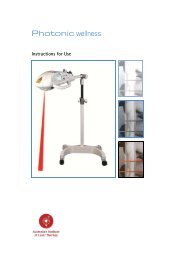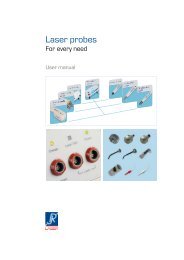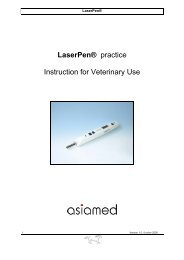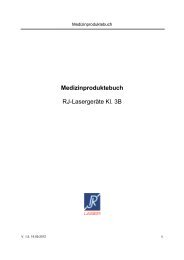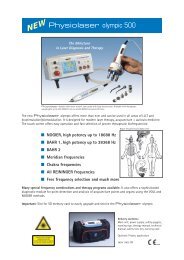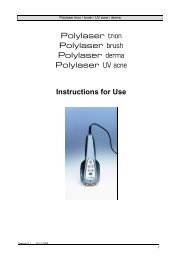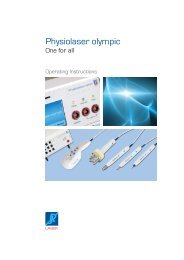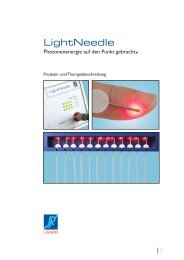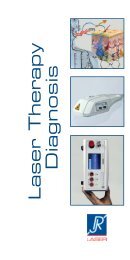LightNeedle - RJ Laser
LightNeedle - RJ Laser
LightNeedle - RJ Laser
Create successful ePaper yourself
Turn your PDF publications into a flip-book with our unique Google optimized e-Paper software.
12<br />
Abstracts <strong>Laser</strong> Acupuncture<br />
<strong>Laser</strong>needle Acupuncture: A Critical Review and Recent Results<br />
Detlef Schikora, PhD<br />
In the last 5 years, laserneedle acupuncture has become a new category in acupuncture, with its<br />
own scientific basics. It combines the tradition of Chinese acupuncture with the possibilities of<br />
modern technology. <strong>Laser</strong>needle acupuncture is in accordance with the aim of traditional medicine<br />
because it uses the most essential and most natural medium of our existence, the light,<br />
to heal illnesses. The painless laserneedle acupuncture is of proven medical effectiveness and<br />
particularly suited for the treatment of children and those patients who regard the metal needle<br />
insertion into the skin as unpleasant. In daily practical use, laserneedle acupuncture can<br />
be performed like any traditional needle acupuncture treatment.<br />
The diagnostic criteria of acupoint selection, the treatment duration, and treatment frequency<br />
are identical to the traditional Chinese acupuncture. To perform successful laserneedle acupuncture<br />
treatments, no additional qualification is required.<br />
Offering the painless laserneedle acupuncture to the patient means that the acupuncture needles<br />
are substituted and the risks of the metal needle are eliminated.<br />
Effect of New Non-invasive <strong>Laser</strong> Needles on Brain Function<br />
G. Litscher*, D. Schikora**<br />
* Department of Biomedical Eng. and Research in Anesthesia and Critical Care,<br />
University of Graz, Graz, Austria<br />
** Department of Physics and Optoelectronic, University of Paderborn, Paderborn, Germany<br />
This paper describes the first double-blind study in acupuncture research in 17 healthy<br />
volunteers using laserneedle acupuncture. Stimulation of vision related acupoints resulted<br />
in marked changes of mean blood flow velocity in the posterior cerebral artery measured by<br />
multidirectional transcranial Doppler sonography. Further studies using different laser stimulus<br />
intensities and wavelengths are in progress.<br />
Cerebral Vascular Effects of Non-invasive <strong>Laser</strong>needles Measured by Transorbital<br />
and Transtemporal Doppler Sonography<br />
G. Litscher1 and D. Schikora2<br />
1Department of Biomedical Engineering and Research in Anesthesia and Critical Care, University<br />
of Graz, Austria; 2Department of Physics and Optoelectronic, University of Paderborn, Germany<br />
<strong>Laser</strong>needles represent a new non-invasive optical stimulation method which is described for<br />
the first time in this paper. We investigated 27 healthy volunteers (mean ageSD: 25.154.12<br />
years; range: 21–38 years; 14 female, 13 male) in a randomised cross-over trial to study differences<br />
between laserneedle acupuncture and manual needle acupuncture in specific cerebral<br />
parameters. Mean blood flow velocity (vm) showed specific and significant increases in the<br />
ophthalmic artery during laserneedle stimulation (p=0.01) and during manual needle stimulation<br />
(p



